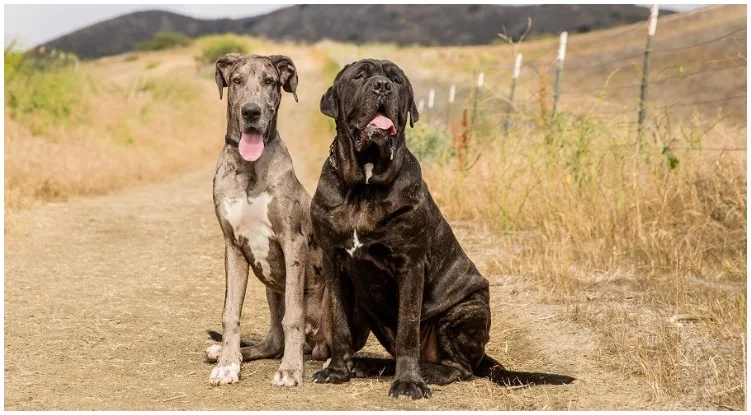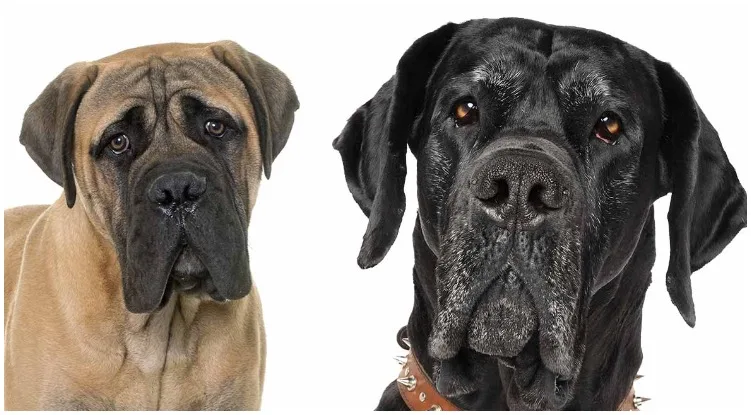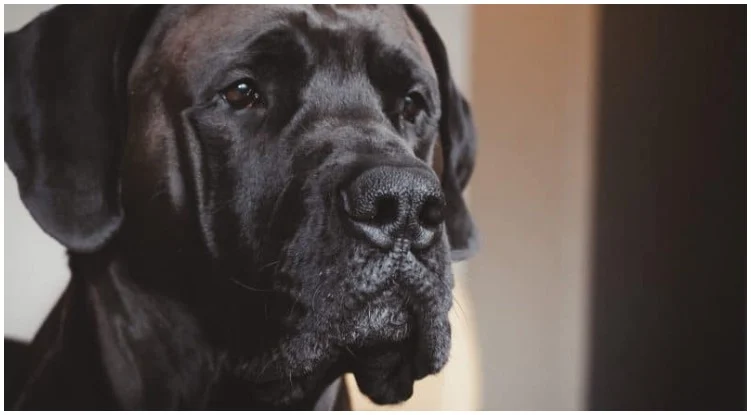You can probably already guess that the Great Dane Mastiff mix is going to be a huge dog! And they really are giants — but gentle giants. Both of their parent breeds are known to be sweet and affectionate pups. And no matter how big these dogs get, they will always believe that they are lap dogs!
Like the name already says, the Great Dane Mastiff Mix is a crossbreed between the Great Dane and the English Mastiff dog. It’s unknown how this crossbreed was first produced. They are fairly new, so some things are still unknown.
If you want to learn more about the Great Dane Mastiff mix dog, keep on reading this article.
Mastiff Great Dane Mix History
All hybrid or designer dogs are difficult to read because they don’t have much history. Breeding certain dogs like this has become common in the last twenty years, although I am sure that this mixed breed has found its share of dogs in the shelter due to accidental breeding. In the following, we will take a closer look at the history of the two parent breeds.
The Daniff is not recognized by the American Kennel Club, as it is considered to be a hybrid breed. But it is recognized by the American Canine Hybrid Club (ACHC), the Designer Breed Registry (DBR), the Designer Dogs Kennel Club (DDKC), the Dog Registry of America, Inc. (DRA), the International Designer Canine Registry (IDCR), and the Daniff Kennel Club (DKC).
History of the Great Dane
Already in the 14th to 13th century BC In ancient times, large boar dogs resembling the Mastiff appear in Greece.
The History Museum of the University of Copenhagen contains at least seven skeletons of large dogs, which date from the fifth century BC. Obviously, very large dogs were already part of our history thousands of years ago.
Mid 16th century, the Central European nobility imported strong, long-legged dogs from England. These English dogs came from crossroads between English Mastiffs and Irish Wolfhounds.
The purpose of these extremely large dogs was hunting bear, boar, and deer. They were also the perfect guard dog. The favorite dogs were allowed to spend the night in the bedrooms of their masters. These so-called chamber dogs were there to protect the rich while they were sleeping.
We don’t know when the first Great Dane came to the US, or even where they came from, but the Great Dane Club of America was formed in 1889. It was the fourth breed club allowed to join the American Kennel Club.
History of the English Mastiff
The ancestor of the English Mastiff is the Tibetan Mastiff. This is one of the oldest dog breeds. He originally comes from Tibet, where he worked as a guarding dog that either traveled with nomadic shepherds, watched over their herds or served as a protector of villages and monasteries. Travelers also often wrote about these dogs.
English Mastiffs are a large working race that is literally thousands of years old. They were used in bait sports to kill bulls and bears, often in the arena. Fortunately, this was ended in Great Britain in the 1830s.
Mastiffs came to the United States in colonial times, but it wasn’t until 1879 that the first Mastiff club was formed. The American Kennel Club recognized this breed in 1885.
Appearance
If you are here looking at this crossbreed chances are that you love big dogs and you cannot lie. And a Great Dane Mastiff mix definitely is one of them!
These pups grow incredibly quickly and just in a blink of the eye will your puppy become big enough to knock you over out of excitement when you come home.
Most Great Dane Mastiff mixes will reach their full size at two years of age. Like we already said — these dogs are giants! Be prepared that your Daniff will grown to be anywhere from 28 to over 30 inches tall and weigh between 110 to over 280 pounds.
When it comes to their coat, they will inherit a short, single coat from their parent breeds.

There are many color variations in which a Great Dane Mastiff mix dog can come, the most common ones are:
- Black
- Grey
- Fawn
- Blue
- Brown
However, take into consideration that this is a crossbreed — that means that you never know what exactly you are getting. A mix dog can lean more to the appearance of any of the two parent breeds. Sometimes they will look more like a Great Dane, while other times they will look more like a Mastiff.
Grooming
Thanks to their short coat that just has one single layer, the Daniff is a fairly low-maintenance dog. They don’t shed too much except for the seasonal shedding.
However, if your Great Mastiff dog inherits his Mastiff parent’s jowls, he could be a drooler.
In that case, you’ll want to keep a rag handy to wipe his mouth from time to time.
You won’t have to bathe your Daniff too frequently as well. A bath every two to three weeks will be more than fine.
Don’t forget to clean your dog’s ears to prevent infections or wax build up.
Additionally, also brush his teeth and make sure to clip his nails when necessary.
Personality
Even though that these dogs may seem a bit intimidating due to their large size — they are actually total sweethearts!
Their personality, however, will also largely depend on the way you raised your dog.
If trained well, and if the socialization process started early on — Daniffs are friendly, well-rounded and family oriented dogs.
They are calm and patient with kids, and get along with other animals too.
The Great Dane Mastiff mix takes up a lot of space, obviously. However, he also loves to sit on your furniture — so make sure that your couch is big enough. They also need a lot of food, attention, exercise and love! Make sure you are meeting all of their needs.
In return, you will get a dog that couldn’t be sweeter even if he tried. The Daniff will become your best friend and life companion.

Health and Life expectancy
Unfortunately, due to their large size — the life expectancy of this mix breed isn’t too long. In most cases, these dogs will live somewhere between 6 to 10 years.
Due to their large size, these dogs are more prone to skeletal and muscle issues. Common health issues are also heart problems that are mainly caused by the enormous size of the mastiff and the great.
Make sure to feed your dog a healthy and balanced diet and that he gets a lot of exercise. 30-45 minutes a day will be a minimum for such an active and big dog breed.
Some of the health problems that these dogs are prone to are:
- Cardiac diseases
- Eye issues
- Hip and elbow dysplasia
- Hypothyroidism
- Degenerative myelopathy
While you’re here, why not learn about other dog breeds as well:
- Bernedoodle puppies: Five facts to know!
- Schnoodle puppies: The cutest hybrid breed ever
- Golden retriever Chow mix: Golden Chow
- Pitbull Beagle Mix: A very unusual hybrid dog
- Pitbull Dachshund Mix: Complete Guide

